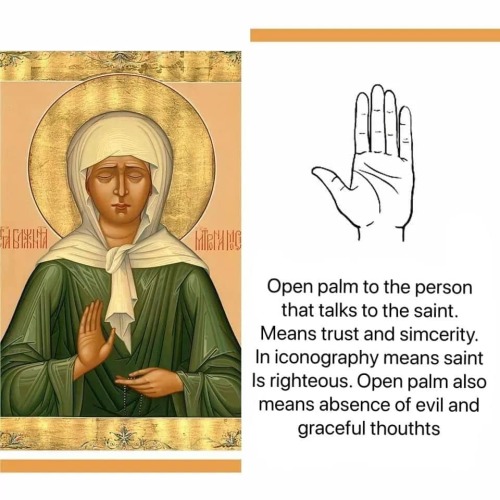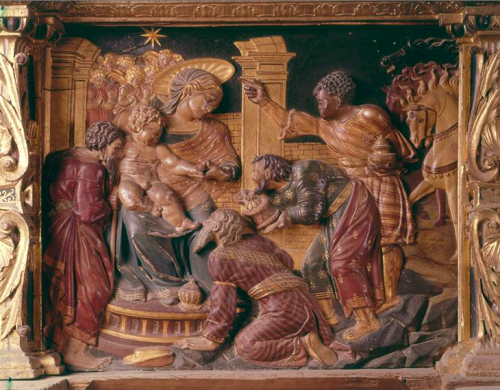St. Margaret Emerging From The Dragon That Swallowed Her

st. margaret emerging from the dragon that swallowed her
in the "breviary of jost von silenen", valais, c. 1493
source: Zurich, SNM, LM 4624.2, fol. 289r
More Posts from Babel2001 and Others









Hand gestures and their meaning in iconography and religious paintings.
back in the day medieval times was so big it covered all of europe. now its so small it fits in some restaurants
In what follows, however, I want to draw attention to a context where women had a role that was culturally and socially significant and where consequently some effort was made to police the relations that they formed with one another in terms that implicated the erotic. Anchorites were men or women who attempted to mimic the eremitic lifestyle of the desert fathers by dedicating themselves to a life of solitary confinement in a cell or “anchorhold,” usually under the spiritual direction of a bishop. While the reclusive life was adopted by individuals from the early Middle Ages until well into the sixteenth century, statistical surveys have shown that in England anchoritism reached its apogee in the thirteenth century and that, in this period, women adopting the lifestyle outnumbered men by a ratio of roughly four to one. Although, on the surface, the solitary nature of Journal of Medieval Religious Cultures the anchorite’s vocation seems to preclude the kinds of socially valued and politically potent relationships that characterize premodern discourses of male friendship, in England at least the centrality of anchorites to medieval communities is apparent. English anchoritism was a fundamentally social phenomenon, sustained by networks of patronage, material support, and verbal and textual interaction; the relationships forged among recluses, and with others beyond the confines of the cell, potentially possessed an importance beyond mere practical necessity. If, as Robert Hasenfratz has recently put it, “many anchorites withdrew from the world only to find themselves in the center of village life,” the anchorhold is best understood not simply as a space of physical isolation but also as a transactive site, a location within which bonds could be formed and networks sustained. Contemporary discourses of friendship may thus have exerted an influence on the lives of individuals who, on another level, remained dead to the world.
Robert Mills. “GENDER, SODOMY, FRIENDSHIP, AND THE MEDIEVAL ANCHORHOLD.” Journal of Medieval Religious Cultures 36, no. 1 (2010): 1–27. https://doi.org/10.5325/jmedirelicult.36.1.0001.


Juan de Balmaseda
Carved Predella: Adoration of the Magi
Spain (c. 1516-1525)
Polychrome Wood, 68 x 83 cm.
Palencia, Seo. Capilla de San Ildefonso.
The Image of the Black in Western Art Research Project and Photo Archive, W.E.B. Du Bois Institute for African and African American Research, Harvard University

any good medieval butterflies?



I like these guys from Morgan Library MS M.358! this is also just a fun manuscript to look at because it is unfinished and you can see the artist's process making the borders by looking at the incomplete folios


loose sketches of some Pelagien outfits... travelling and sleeping
notes under readmore:
the travelling outfit is based on some c13th and 14th sources which describe large hoods and cloaks
i opted to not do a particularly priest-y look - he's not trying to draw attention while moving
i am so aware of the debate on whether medieval people slept naked. 95% of the sources of people doing this are either from warm climates (like portugal) or depict nobles with access to good bedding and servants to heat their chambers - other people would probably sleep in underwear or specific sleep clothes. i've opted for a c14th set of a mens short undertunic and braies
i am making wild extrapolations as to what a guy with a very specific set of experiences (ftm . clericus vagans . autistic . lower middle class in the 1300s) would wear . allow a guy some creative liberty
-
 love-and-death-from-above liked this · 2 weeks ago
love-and-death-from-above liked this · 2 weeks ago -
 oblivioustoast liked this · 2 weeks ago
oblivioustoast liked this · 2 weeks ago -
 meple-leef liked this · 2 weeks ago
meple-leef liked this · 2 weeks ago -
 vtimeisteatime reblogged this · 2 weeks ago
vtimeisteatime reblogged this · 2 weeks ago -
 oopsabird liked this · 2 weeks ago
oopsabird liked this · 2 weeks ago -
 queerpyracy reblogged this · 2 weeks ago
queerpyracy reblogged this · 2 weeks ago -
 lebeaudenouement reblogged this · 2 weeks ago
lebeaudenouement reblogged this · 2 weeks ago -
 lebeaudenouement liked this · 2 weeks ago
lebeaudenouement liked this · 2 weeks ago -
 iraealmond reblogged this · 2 weeks ago
iraealmond reblogged this · 2 weeks ago -
 iraealmond liked this · 2 weeks ago
iraealmond liked this · 2 weeks ago -
 famous-clairvoyante-sosostris liked this · 2 weeks ago
famous-clairvoyante-sosostris liked this · 2 weeks ago -
 swtfrmx reblogged this · 2 weeks ago
swtfrmx reblogged this · 2 weeks ago -
 apokalypsis reblogged this · 2 weeks ago
apokalypsis reblogged this · 2 weeks ago -
 dcrow1312 liked this · 3 weeks ago
dcrow1312 liked this · 3 weeks ago -
 thefruitcurator reblogged this · 3 weeks ago
thefruitcurator reblogged this · 3 weeks ago -
 davidbarlowe liked this · 3 weeks ago
davidbarlowe liked this · 3 weeks ago -
 azmbiexxplorer liked this · 3 weeks ago
azmbiexxplorer liked this · 3 weeks ago -
 nothingtoseemoveon reblogged this · 3 weeks ago
nothingtoseemoveon reblogged this · 3 weeks ago -
 nothingtoseemoveon liked this · 3 weeks ago
nothingtoseemoveon liked this · 3 weeks ago -
 lexi-anastasia-astra-luna liked this · 3 weeks ago
lexi-anastasia-astra-luna liked this · 3 weeks ago -
 ravaani reblogged this · 4 weeks ago
ravaani reblogged this · 4 weeks ago -
 an-v liked this · 4 weeks ago
an-v liked this · 4 weeks ago -
 kajepan reblogged this · 1 month ago
kajepan reblogged this · 1 month ago -
 stringsofglass reblogged this · 1 month ago
stringsofglass reblogged this · 1 month ago -
 longsuffering-fossil liked this · 1 month ago
longsuffering-fossil liked this · 1 month ago -
 sirikenobilegends liked this · 1 month ago
sirikenobilegends liked this · 1 month ago -
 captainpunchmerica reblogged this · 1 month ago
captainpunchmerica reblogged this · 1 month ago -
 flowersinthedustbin liked this · 1 month ago
flowersinthedustbin liked this · 1 month ago -
 maidofyesteryear reblogged this · 1 month ago
maidofyesteryear reblogged this · 1 month ago -
 riounchartedwhous reblogged this · 1 month ago
riounchartedwhous reblogged this · 1 month ago -
 riounchartedwhous liked this · 1 month ago
riounchartedwhous liked this · 1 month ago -
 crematedequally reblogged this · 1 month ago
crematedequally reblogged this · 1 month ago -
 slytherintothedragonsden liked this · 1 month ago
slytherintothedragonsden liked this · 1 month ago -
 wearebut2tardust liked this · 1 month ago
wearebut2tardust liked this · 1 month ago -
 henrytudors liked this · 1 month ago
henrytudors liked this · 1 month ago -
 mikumylove liked this · 1 month ago
mikumylove liked this · 1 month ago -
 kikoutei reblogged this · 1 month ago
kikoutei reblogged this · 1 month ago -
 girlfriencl reblogged this · 1 month ago
girlfriencl reblogged this · 1 month ago -
 scrycrystal liked this · 1 month ago
scrycrystal liked this · 1 month ago -
 astroczad reblogged this · 1 month ago
astroczad reblogged this · 1 month ago -
 eoeieue reblogged this · 1 month ago
eoeieue reblogged this · 1 month ago -
 etherealdragonsrealm reblogged this · 1 month ago
etherealdragonsrealm reblogged this · 1 month ago -
 chakraheart521 liked this · 1 month ago
chakraheart521 liked this · 1 month ago

what it says on the tin - a collection of bits and pieces i may want to refer back to. you're welcome to follow!
28 posts


